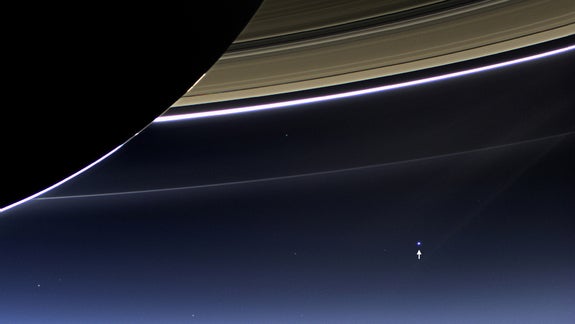Earth wades through the Perseid meteor stream
ListenEarlier this month NASA’s Cassini spacecraft, collecting valuable data as it orbits Saturn had a rare opportunity to capture an image of our planet and our moon from 898 million miles away, one of the rarest type of photos from space.In addition, the Messenger satellite orbiting Mercury took a photo of Earth from just 61 million miles away.
July 29, 2013
[Dave Heller] Planet Earth is embarking on its annual walk through the Perseid meteor stream. Let’s take our trek with Derrick Pitts, chief astronomer at the Franklin Institute. Derrick, our toes are at the water’s edge, guide us through to the other side.
[Derrick Pitts] I’d be happy to. It’s a great trip every year, we get to do the same thing. And I love sort of relating this to the idea of walking through a forest stream in the summer, with this idyllic view of a lovely wooded glen with a lovely stream running through … And you know, this is very much similar to what the Earth is doing as it passes through the stream of dust that comes from the comet 109P Swift-Tuttle. But as the nucleus of the comet orbits the sun closely, it releases dust. So every year, the orbit of the comet and the orbit of the Earth intersect. And this intersection comes to its culmination, if you will, on August 12, the peak of the Perseid meteor shower. So here’s how the stream walk goes: About July 27, that’s two days ago, the Earth started to reach the outer edge of this stream of meteors. This is like being on the edge of the bank of the stream in the woods. And the Earth gradually works its way closer toward the center of the stream, and it’s just like us with our toes dipping into the water on the edge of the bank. And as we get to the center of the stream where the water is deepest, and hopefully it’s a mountain stream so it’s nice and cold, the Earth gets to the middle of the stream on August 12.
It feels like cold water. What will it look like?
What it will look like is we’ll be able to see, if we could just right, maybe as many as 100 meteors per hour. They seem to be all over the sky, although they are actually emanating from one particular direction that we see in the constellation Perseus, which is why we call it the Perseid meteor shower. These little tiny bits of dust and dirt are not coming from the constellation, but that’s the direction that the stream of meteors seems to be coming. The path of the comet is in that direction.
“What it will look like is we’ll be able to see, if we could just right, maybe as many as 100 meteors per hour. They seem to be all over the sky.”
Derrick Pitts
-
Time-lapse video of Perseid meteor shower
How does the Perseid compare to other showers of note, say the Geminid?
The Perseid meteor shower has always, for a long time, had been recognized as the most intense meteor shower of the year, giving us somewhere between 60 and 100 meteors per hour. That’s a pretty good number. But the Geminid meteor shower in December now outranks the Perseid meteor shower because it will show up to 120 per hour. Of course the big difference is it’s warmer in the summer than in December.
Derrick, once upon a time it was heresy to suggest that the Earth wasn’t the center of the universe. Now obviously Earthlings back then didn’t have access to Cassini’s spacecraft-generated images.
Indeed, you’re right. We’ve been able to make use of this spacecraft now to indeed show us how far we are away from the center of anything. Except of course our own egos! In any case, the Cassini spacecraft — which is orbiting Saturn, gathering information about that system of the planet and its moons — has sent us a wonderful picture of us and our companion moon. We look like a little, pale blue dot. And I do mean small, and pale and a dot! It really shows us what the significance of our planet is, when we consider ourselves in the great collection of everything else in our solar system and really in the rest of the galaxy. But at the same time, that little dot is the only place where all of the people we have ever known have ever lived. It’s the only place that we know of so far in the universe that has any sort of life. And if you go to our website you’ll find a link that will take you to a beautiful image of not only the Earth as taken from Saturn, but also in the same week, 10 days ago, Earth as taken from the orbit of the planet Mercury by the Messenger spacecraft at 61 million miles away. Like, we’ve been photo-bombing the planet!
-


Earth and Moon: Views from Saturn & Mercury. Photo credit: Space.com
WHYY is your source for fact-based, in-depth journalism and information. As a nonprofit organization, we rely on financial support from readers like you. Please give today.




